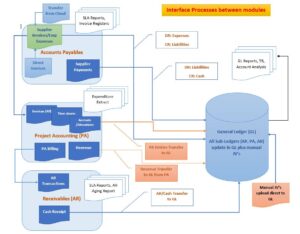Integration between Financial Modules and Transaction types
In Oracle R12, Payables, Receivables, Projects, and General Ledger (GL) are seamlessly integrated through various processes to ensure accurate financial reporting and project cost tracking. Payables and Projects integrate to track project-related supplier costs, while Receivables integrates with Projects to process draft invoices and track customer payments. GL serves as the central hub, receiving transactions from other modules through interface tables and the Journal Import program

1. Payables and Projects:
Tracking Supplier Costs:
Oracle Payables allows you to match supplier invoices to existing purchase orders and automatically copy project information, such as project ID and task ID, from the purchase order to the invoice.
Creating Accounting:
You can create non-matched supplier invoices and enter invoice distributions to charge invoice costs to specific projects.
Interfacing to Projects:
After creating accounting for an invoice, you can interface project-related invoice distributions to Oracle Projects, transferring the actual costs incurred for the project.
2. Receivables and Projects:
Draft Invoice Generation:
Oracle Projects can generate draft invoices for project-related revenue, which are then interfaced to Oracle Receivables interface tables.
Automated Invoice Creation:
The AutoInvoice process in Receivables then creates formal invoices based on the draft invoices interfaced from Projects.
Interface and Tieback:
Oracle Projects processes are used to interface draft invoices, tie back successfully interfaced invoices, and handle rejected invoices.
3. Projects and General Ledger:
Cost and Revenue Interfaces:
Oracle Projects processes collect eligible cost and revenue distribution lines, summarize them, and interface them to the GL interface table.
Journal Import:
The Journal Import program then creates journal entries for cost and revenue transactions, which you can post to GL at any time.
Tieback and Reconciliation:
You can tieback cost and revenue items to Oracle Projects to confirm successful loading into GL. Standard reports facilitate reconciliation of summary journal entries with project accounting details.
4. General Ledger:
Central Hub:
GL serves as the central repository for all financial data, receiving transactions from Payables, Receivables, Projects, and other modules.
Accounting Entries:
GL maintains balances and turnovers of all accounts, ensuring accurate financial reporting.
Financial Reporting:
GL provides tools for generating financial reports, including balance sheets, income statements, and cash flow statements.
In essence, the Oracle R12 modules are interconnected through interfaces and processes, enabling a flow of data and accounting entries from various points in the financial cycle to GL, which then provides a comprehensive view of the organization’s financial position.